Casio has followed up its 60 frames a second EX-F1 digital camera with the EX-FH20, but is the new model an improvement on the first or does it fall foul of the same complaints? We got zooming and snapping to find out.
Our quick take
If you read our review of the EX-F1 you'll soon see that we weren't impressed by the digital camera. It was large, the controls were fiddly and the resolution wasn't great. While it did its core job of taking lots of pictures very quickly thanks to the high frame rate capturing qualities it failed to offer little else.
The EX-FH20 addresses virtually all our complaints we had with the EX-F1 (thank you) and because of it, it's a far better and more useful camera.
Overall though what it means is that the fast fps capture rate is now just one of many features the FH20 offers rather than the only reason for buying this camera and that can only be a good thing.
A vast improvement.

Casio EX-FH20 digital camera - 4.0 / 5
| FOR | AGAINST |
|---|---|
|
|
The new FH20 is smaller, packs a higher resolution sensor and comes with a greater zoom than the EX-F1 meaning it's off to a good start. All that extra punch however does mean things have had to be cut back: the frame rate has been dropped from 60 fps down to 40fps.
Almost half the size of the EX-F1 the EX-FH20 sports a 9.1-megapixel sensor, a 20x optical zoom and a bigger 3-inch LCD screen. While the screen is bigger (you also get an electronic viewfinder), the camera offers a more traditional and therefore easier to use layout and the complaints of a complicated design that we found with the EX-F1 have gone completely. This is mainly due to a single dial on the top of the camera, rather than two dials as in the FX-E1 and the removal of an additional toggle switch.
Like the EX-F1 the focus is on capturing images fast, however here the 20x optical zoom makes the camera considerably more useful than the 12x optical in the previous model.
20x means you can see things in clear detail that you can't even see clearly on a standard un-zoomed picture (see images) and take this to a sporting event or the safari and you'll be snapping images as if you really were next to that lion or 100m sprinter.
Working in an identical way to the EX-F1 the camera is capable of taking 40 shots in a single second at the press of the button. It's great for capturing action as it means you've got 40 images to choose from rather than just the one. Images are saved in a collection on the camera, but singularly on download to your computer and all you've got to do is filter out the ones you don't like.
Like the EX-F1, the camera offers a high-speed video mode as well, however like the still image "frames per second" rate, the EX-FH20 capabilities have been reduced to 1000 rather than 1600fps over the EX-F1.
As before the higher the frame rate, the lower quality of the video footage that is recorded, however if you are recording at around 30 frames a second - which is still slow-motion enough to make everyone looking like they are moving incredibly slowly - it will record at 480 x 360 resolution. It's not going to be high-def, but enough to view back on a large screen.
If the video is destined for YouTube, the camera also features Casio's YouTube Capture mode that records in MPEG4 H.264 high quality video format; the premise is that it records the footage in the ideal compression ratio that allows you to record longer movies without having to sacrifice quality.
So the hardware is a vast improvement over the previous outing but does it take good pictures? Well luckily the answer is yes.
Colours are well balanced, focus sharp and that zoom very impressive. The flash doesn't over bleach the images when used and while the frame rate capture speed has been reduced from 60 to 40 frames per second, for the majority of users, you aren't going to notice the difference.
On the video front we found the best results were recording at between 30 and 201fps. The top whack of 1000fps suffers from the same problem as the EX-F1 - in that the resolution is dropped 224 x 58 and therefore becomes incredibly grainy. You also suffer from a very tight letterbox effect.
To recap
The EX-FH20 addresses virtually all our complaints we with the EX-F1 (thank you)
